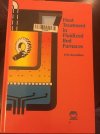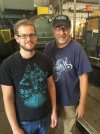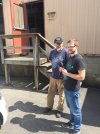-
The BladeForums.com 2024 Traditional Knife is available! Price is $250 ea (shipped within CONUS).
Order here: https://www.bladeforums.com/help/2024-traditional/
You are using an out of date browser. It may not display this or other websites correctly.
You should upgrade or use an alternative browser.
You should upgrade or use an alternative browser.
Sand Pot, could it be a salt replacement.
- Thread starter JTknives
- Start date
PEU
Gaucho Knifemaker
- Joined
- Aug 6, 2006
- Messages
- 1,176
I think the only issue with the coil in the bottom with holes is when you shut off the air the sand will run into the holes and fill the tubing.
put the holes facing down
[edit] it was obvious and not the 1st one to have the idea... but, why not let air flow until the sand reaches non fluid characteristics again?
Pablo
Last edited:
Stacy E. Apelt - Bladesmith
ilmarinen - MODERATOR
Moderator
Knifemaker / Craftsman / Service Provider
- Joined
- Aug 20, 2004
- Messages
- 38,235
JT, give Brad a call and ask him again about the flow rate. On a small tank it should be a lot less than he is running, but as you said, the fluidizing is what makes it work.
Also, ask what the minimum tank size would be. I think you need sufficient size to allow the sand to act like a fluid. I would guess that 6" is the practical lower size limit.
Also, ask what the minimum tank size would be. I think you need sufficient size to allow the sand to act like a fluid. I would guess that 6" is the practical lower size limit.
Stacy E. Apelt - Bladesmith
ilmarinen - MODERATOR
Moderator
Knifemaker / Craftsman / Service Provider
- Joined
- Aug 20, 2004
- Messages
- 38,235
Have the holes facing down into your pot.
Dang!, that's a good idea. I will diffuse the air/gas flow as well as keep sand from getting into the tube.
- Joined
- Jun 11, 2006
- Messages
- 8,650
lol. I think the hole facing down has been mentioned like 10
Times but yeah it's a good idea. I will be building a new pot to test this and making
A coil and putting holes in the bottom of the
Coil.
Been doing some reading and I guess a commercial way todo it is by using what looks like mushrooms. The holes are up under the hood and the hood goes down a good
Bit so the
Air has to push down and then comes up around the rim of the cap. For all intents and purposes our pot is micro in siZe compared to industrial fludizing beds.
I think Stacy is right on the money though in needing a larger size. And I think one big reason for needing the larger size is sand volume. In such a small pot when you insert a bar or blade the level comes up quite a bit. But in a larger pot you would not have as drastic of a rise. Also the sand close to the sides
Of the pot seam to have different properties then the middle fluidised section. I don't know the size limit where it's big enough vs to big but that will have to be tested out. But I don't thing the 5-6" diamater is out of the ball park.
Times but yeah it's a good idea. I will be building a new pot to test this and making
A coil and putting holes in the bottom of the
Coil.
Been doing some reading and I guess a commercial way todo it is by using what looks like mushrooms. The holes are up under the hood and the hood goes down a good
Bit so the
Air has to push down and then comes up around the rim of the cap. For all intents and purposes our pot is micro in siZe compared to industrial fludizing beds.
I think Stacy is right on the money though in needing a larger size. And I think one big reason for needing the larger size is sand volume. In such a small pot when you insert a bar or blade the level comes up quite a bit. But in a larger pot you would not have as drastic of a rise. Also the sand close to the sides
Of the pot seam to have different properties then the middle fluidised section. I don't know the size limit where it's big enough vs to big but that will have to be tested out. But I don't thing the 5-6" diamater is out of the ball park.
jdm61
itinerant metal pounder
- Joined
- Aug 12, 2005
- Messages
- 47,357
Like I said before, if you could make say a 8 inch oblong pot work, you would have a winner because then you could put darn near anything in it. You should check out the video that James Helm has on line that shows his modified pottery kiln that he uses to austenize his tomahawks.
lol. I think the hole facing down has been mentioned like 10
Times but yeah it's a good idea. I will be building a new pot to test this and making
A coil and putting holes in the bottom of the
Coil.
Been doing some reading and I guess a commercial way todo it is by using what looks like mushrooms. The holes are up under the hood and the hood goes down a good
Bit so the
Air has to push down and then comes up around the rim of the cap. For all intents and purposes our pot is micro in siZe compared to industrial fludizing beds.
I think Stacy is right on the money though in needing a larger size. And I think one big reason for needing the larger size is sand volume. In such a small pot when you insert a bar or blade the level comes up quite a bit. But in a larger pot you would not have as drastic of a rise. Also the sand close to the sides
Of the pot seam to have different properties then the middle fluidised section. I don't know the size limit where it's big enough vs to big but that will have to be tested out. But I don't thing the 5-6" diamater is out of the ball park.
Bigfattyt
Gold Member
- Joined
- Jun 23, 2007
- Messages
- 19,240
Shoot JT, I may have to come visit!
Remember that 5160 I got from you in UT? That big 5160 chopper I started with you has still not been heat treated!
I made a smaller knife and heat treated it in my hibachi and quenched in motorcycle race oil.
Remember that 5160 I got from you in UT? That big 5160 chopper I started with you has still not been heat treated!
I made a smaller knife and heat treated it in my hibachi and quenched in motorcycle race oil.
Got the book in. It looks pretty good, not a lot more info then has already been discussed. Me, my wife and daughter took a trip to Pittsburgh in July to visit Larrin and his family. During the trip we visited Peters HT along with US Steel, Case Cutlery, and a couple of custom makers.
Peters was very impressive, Brad is a real gentleman. It was obvious that they are very organized and professional. Loved the visit. We seen the whole operation along with the fluidized bed furnace.
After we got home, I ordered the book about fluidized bed heat treating. Just came in. After I have a chance to read it I'll let everyone know if there is some thing note worthy.
Pics of the book, Larrin and Brad, and the Peters truck.
Hoss
Peters was very impressive, Brad is a real gentleman. It was obvious that they are very organized and professional. Loved the visit. We seen the whole operation along with the fluidized bed furnace.
After we got home, I ordered the book about fluidized bed heat treating. Just came in. After I have a chance to read it I'll let everyone know if there is some thing note worthy.
Pics of the book, Larrin and Brad, and the Peters truck.
Hoss
Attachments
jdm61
itinerant metal pounder
- Joined
- Aug 12, 2005
- Messages
- 47,357
We look forward to hearing what you find out, Hoss.
Got the book in. It looks pretty good, not a lot more info then has already been discussed. Me, my wife and daughter took a trip to Pittsburgh in July to visit Larrin and his family. During the trip we visited Peters HT along with US Steel, Case Cutlery, and a couple of custom makers.
Peters was very impressive, Brad is a real gentleman. It was obvious that they are very organized and professional. Loved the visit. We seen the whole operation along with the fluidized bed furnace.
After we got home, I ordered the book about fluidized bed heat treating. Just came in. After I have a chance to read it I'll let everyone know if there is some thing note worthy.
Pics of the book, Larrin and Brad, and the Peters truck.
Hoss
My book has not showed up yet and I think I ordered it a few days befor you. Must take longer to ship to the middle of no where lol
I ordered mine before you started the thread. Took forever to get here.
Hoss
I have been thinking about this technology and it seems almost perfect in simplicity except for one problem and it's the shielding gases.
The air in this system is both the key and the curse. If you could eliminate the oxygen from this system. You would have a simple system that almost entirely eliminates scale.
The problem is that you need the air to liquefy the sand so you can keep temperatures even.
I know you are just now experimenting with this. But perhaps mechanical vibration would be enough to move the sand to keep temperatures constant?
If this works and it's enough to keep the sand moving enough to keep temperatures constant in the tube , you could have an oxygen free system you could run entirely from an electrical outlet with no need for extra gas or compressors.
The air in this system is both the key and the curse. If you could eliminate the oxygen from this system. You would have a simple system that almost entirely eliminates scale.
The problem is that you need the air to liquefy the sand so you can keep temperatures even.
I know you are just now experimenting with this. But perhaps mechanical vibration would be enough to move the sand to keep temperatures constant?
If this works and it's enough to keep the sand moving enough to keep temperatures constant in the tube , you could have an oxygen free system you could run entirely from an electrical outlet with no need for extra gas or compressors.




